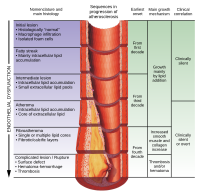
Photo from wikipedia
Regression of atherosclerotic plaque has long been a holy grail of treatment of atherosclerotic cardiovascular disease. The most powerful approach to atherosclerosis regression in multiple species is substantial reduction in… Click to show full abstract
Regression of atherosclerotic plaque has long been a holy grail of treatment of atherosclerotic cardiovascular disease. The most powerful approach to atherosclerosis regression in multiple species is substantial reduction in atherogenic lipoproteins.1 The data for atherosclerosis regression in humans are more limited, but studies with pharmacologic reduction in low-density lipoprotein (LDL) have shown modest regression in atherosclerotic coronary artery disease.2 The contribution of plaque regression, per se, to the reduction in cardiovascular events associated with LDL reduction remains uncertain. However, there remains a substantial residual risk of recurrent cardiovascular events even in the setting of marked reduction in LDL. Objective regression of plaque would be one of the most straightforward findings in phase II that would encourage further clinical development of a novel orthogonal intervention aimed at atherosclerosis. The concept that targeting high-density lipoprotein (HDL) metabolism could be an approach to atherosclerosis regression has been of interest for decades.3 Indeed, studies in several preclinical models have indicated that infusion or overexpression of apo AI (apolipoprotein AI), the major HDL protein, can promote regression. In mice, viral vector–mediated gene transfer and overexpression of apo AI was shown to induce atherosclerosis regression,4 as was transplantation of atherosclerotic aortas into mice transgenically overexpressing apo AI.5 This concept led directly to the idea of infusion of apo AI-containing recombinant particles in humans with atherosclerotic cardiovascular disease,6 an approach that is playing out in a phase III cardiovascular outcomes trial (NCT03473223). A number of groups have shown that diabetic mice experience quantitatively less atherosclerosis regression despite comparable cholesterol-lowering effects.7,8 Comparable data for the effect of diabetes mellitus on regression in humans are not abundant; however, it is well-established that people with diabetes mellitus have increased incidence of atherosclerotic cardiovascular disease and worse cardiovascular outcomes. Individuals with diabetes mellitus not only have lower levels of HDL cholesterol and apo AI, but clear evidence of reduced HDL function including reduced cholesterol efflux capacity and anti-inflammatory function.9 Thus, the hypothesis that diabetes mellitus increases cardiovascular risk (and possibly blunts the impact of antiatherosclerotic therapies) by reducing HDL function is of interest. In this context, Barrett et al in this issue of Circulation10 demonstrate that apo AI overexpression promotes atherosclerosis regression in diabetic mice and elucidate some of the mechanisms by which it may do so. They utilized a model of atherosclerosis regression popularized by the Fisher lab, namely the transplantation of atherosclerotic aortic arches from hypercholesterolemic mice (cholesterol > 1000 mg/dL) into the abdominal aortas of normocholesterolemic wild-type mice © 2019 American Heart Association, Inc.
Journal Title: Circulation
Year Published: 2019
Link to full text (if available)
Share on Social Media: Sign Up to like & get
recommendations!